You can always tell someone who’s talented in the kitchen. We’re no chefs, we say, but we love to cook. But as much as you might love to get creative with dinner, unless you’re some kind of Martha Stewart-level superhero, you’re not going to attempt a souffle on your own. Lucky for us (and for our families), chefs from some of the area’s best restaurants are willing to let us inside their kitchens, give us wine and teach us about their favorite ingredients, cooking hacks, go-to recipes and professional tips of the trade. We might not ever be bound for culinary school, but that doesn’t mean we can’t up our dinner party game. Before the season gets too crazy, spend an afternoon taking a cooking lesson. Your holiday table will thank you.
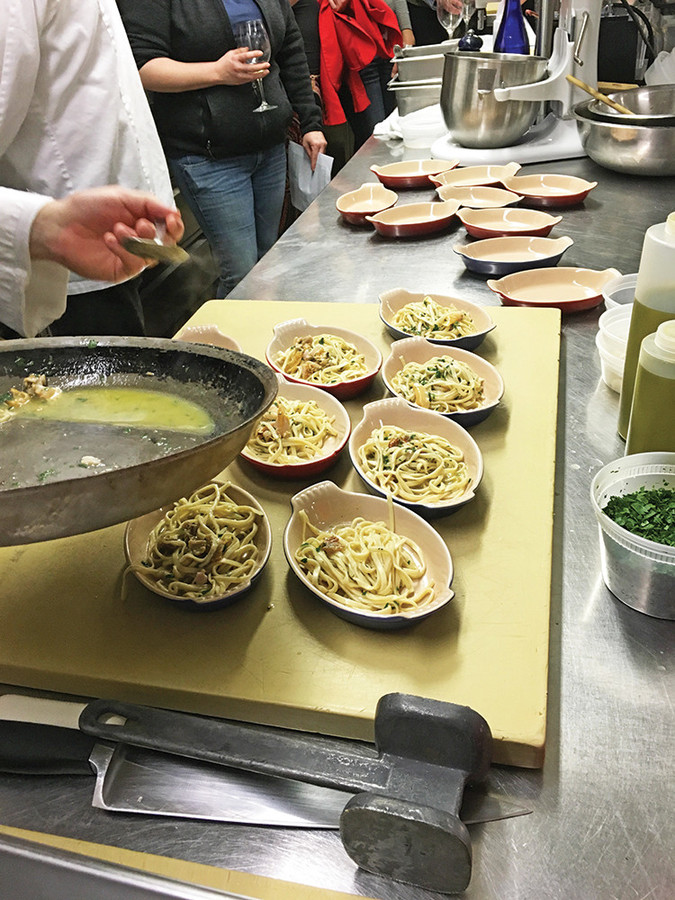
Ingredients shine with chef Matthew MacCartney
Some chefs love complexity: the layering of flavors, taking days to prep a sauce, using tiny bits of exotic ingredients to create a never-before-tasted idea on a plate. And some chefs love simplicity, believing that less is more when it comes to cooking, and that the freshness of the best quality ingredients is what makes a truly successful dish. Chef Matthew MacCartney of Jamestown Fish is definitely in the latter camp. The restaurant is fine dining but not fussy. As Sous Chef Heliovaldo Arajuo describes, “It’s not fancy food. It’s the most truthful. Most dishes have no more than five ingredients. We have such a bounty around here in Rhode Island. All we have to do is create unique combinations of flavors.”
Jamestown Fish offers a handful of cooking classes in their off-season, mostly in the coldest months, and the chefs carry the same philosophy of simplicity to their students as they do their guests. There are 20 or so of us standing in the kitchen of the restaurant on a Saturday afternoon, drinking a well-chosen Italian Rose as the cooking demonstration begins. First up: Linguine and Clams. “You see it on a lot of menus,” Chef Matthew says, “but I think the approach is the important part.” Their approach at Jamestown Fish is to treat the shellfish with a delicate hand, cooking the clams just enough and mostly from the heat of the pasta. “If you can eat the clams raw,” he says, “why are you going to cook them to death?” In his dish, the littlenecks stay very tender, and since the recipe calls for only six ingredients (there is no butter, wine or stock in this recipe), the simple flavor really shines through. “This is sometimes too intense for some people,” Chef Matthew says. “As I say, too much truth. There’s nowhere to hide.”
For the first recipe, Chef has shown us how to shuck clams. For the next, he’ll show us how to “process” a live lobster, then make a stock from the shells and turn the raw lobster meat into Lobster Linguine. It’s not pretty, but the process has an excellent result: instead of working with pre-cooked meat from boiled lobsters, Chef Matthew is able to delicately prepare the lobster and create an incredibly simple dish. Lobster Linguine has only six ingredients – granted, one of them is black truffle butter, and he added some fresh black truffle as a surprise – but the taste is unbelievable. “Make it all about the lobster,” he says. “That’s the chef’s trick here.”
The same is true of dessert, which is a rustic Chestnut Torte. It has seven ingredients, and takes about five minutes to prepare for baking – but it’s exactly the uncomplicated, sweet ending you want to a hearty meal. There really is beauty in simplicity, even on the plate. Jamestown Fish offers cooking classes during the winter.
JamestownFishRI.com
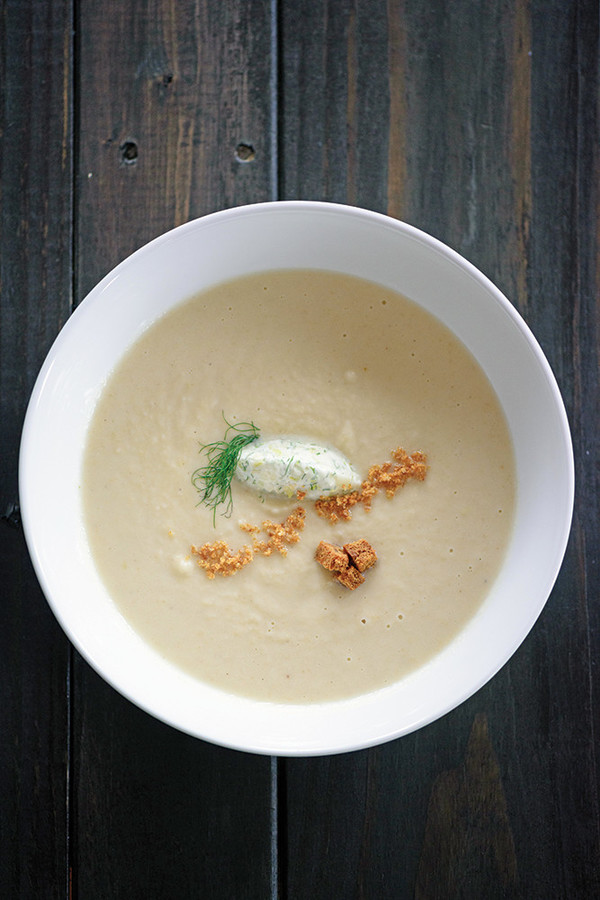
Apples to Apples from Ella's Fine Food and Drink
At Ella’s Fine Food and Drink in Westerly, Chef Jeanie Roland has put together a menu full of subtle layers of flavor and unexpected combinations. Her goal in her classes is to break down the components of what seem like very complicated dishes so that we can recreate them at home in simple, easy ways. Tonight, we’ll be learning All About Apples, where she walks us through three different ways to prepare fall’s favorite fruit.
We start with an autumn soup that is being served downstairs as a special that week. But first, we’ve got to learn about some new ingredients. She holds up a wormy looking thing that’s about the size of a cantaloupe. “Has anyone ever cooked with celeriac before?” We shake our heads. “It’s a great ingredient,” she promises, and it’s not as scary as it looks. Celeriac, or celery root, tastes like celery without the bitterness, Chef Jeanie explains. She likes to use it in cole slaw for some added flavor, or make chips or a gratin out of it. As she’s chopping an onion that will be the base of the apple and celeriac soup, she gives us a pro tip: glide your knife gently through an onion, rather than pushing down hard and letting out all the juice. “The cell is built to hold flavor,” Chef Jeanie explains. “When you mash the onion when you chop it, you lose all the flavor.” As she cooks, servers bring us bowls of garnish that don’t have any soup inside – then someone comes out with a teapot, and starts pouring soup. It’s an impressive show. “This is a great make-ahead first course,” she says. “Imagine serving this at a dinner party.” The soup tastes like fall, but without the expected cinnamon and squash flavors of the season.
Next up: Double Apple Endive and Blue Cheese Salad with Toasted Hazelnut Vinaigrette. Sounds complicated, right? But it’s really just a combination of a few well chosen ingredients: endive, Granny Smith and Cortland apples, blue cheese and toasted hazelnuts, topped with one of the salad dressings Chef Jeanie makes from scratch for the restaurant. In this one, she uses balsamic vinegar, olive oil and hazlenut oil to complement the nuts on the salad. It takes just a minute or two in the blender to make, and the depth of flavor is something you never would have thought you could make with just a few ingredients in your home kitchen. Just like the soup, the salad is seasonal and unexpected. In any dish, she says, you want a balance of flavors: sweet, salty, bitter. Here, the sweetness of the apple pairs beautifully with the salty cheese and the bitter greens.
The last dish Chef Jeanie prepares for us is an Apple Brown Butter Tart with Apple Brandy Semifreddo – individual savory, buttery treats topped with poached apples and a soft frozen ice cream. The recipe is definitely complicated: you make the dough and the ice cream from scratch, and prepare the dessert in stages. But, Chef Jeanie emphasizes, you can prep different stages days in advance, so it doesn’t feel like very much work for an impressive finale. While she works and I enjoy my dessert, I ask her how she would modify the recipe for Thanksgiving. It turns out the delicate treat holds up well enough for the 12-hour drive I’m going to make for my Turkey Day. Chef Jeanie also makes an inspired suggestion for the leftover vanilla bean she used in the recipe: infusing it into bourbon to enjoy with dessert. Chef Jeanie will present Ella’s Thanksgiving Class on November 12, and a Christmas Day Class on December 10.
EllasFineFoodAndDrink.com
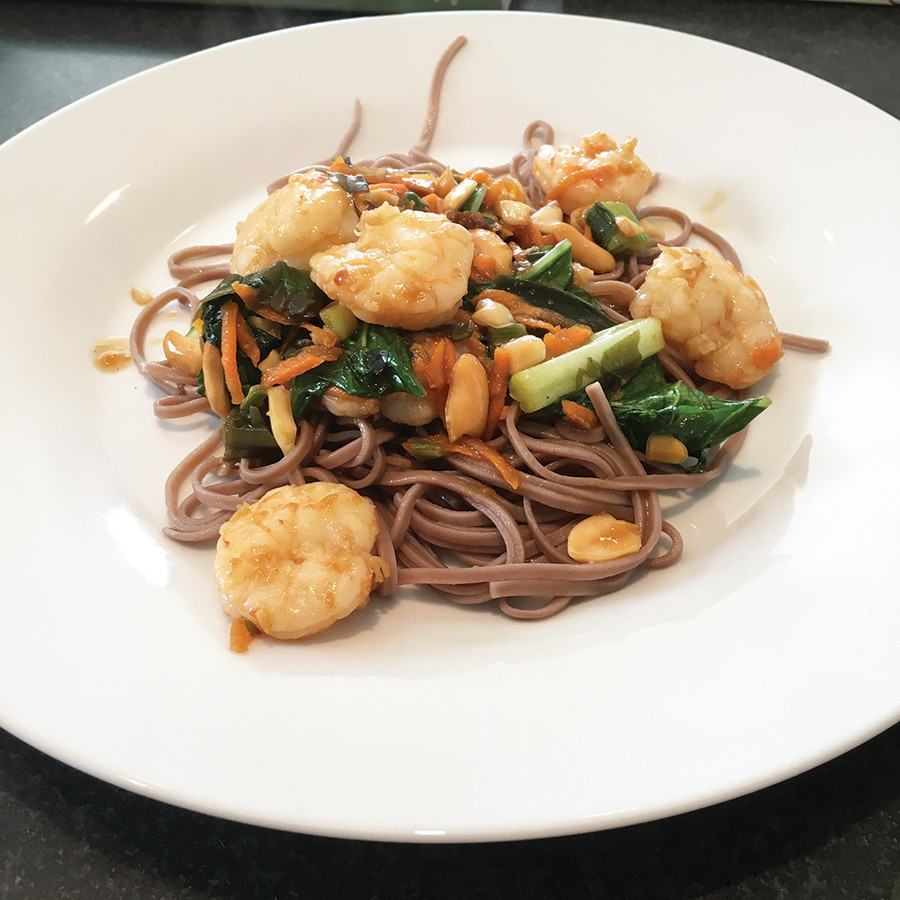
The other bounty of the sea with Conscious Cuisine
When you think of delicious things that come from the ocean, seaweed is definitely not at the top of that list. Yes, seaweed salad is tasty, and yes, seaweed is an important part of sushi, but when Brett Mayette invited me to his Cooking With Sea Vegetables class in Narragansett, I couldn’t think of another way that I would actually want to eat it. It turns out there are a lot of easy and delicious applications in the kitchen for seaweed, and a lot more varieties and flavors than I expected.
But before we get into how you can eat seaweed, let’s talk about why you would ever want to. “Seaweed has vitamins and minerals from the sea, plus trace minerals which are hard to find in foods and are really important to health,” Brett says. “My goal is to show people how to incorporate these things into familiar foods.” Through his decades of work in the food industry – you’ve probably seen him before at Basil’s of Narragansett, where he worked for years – Brett developed a passion for using food as medicine. He has done an apprenticeship as an herbalist, and founded Conscious Cuisine. His goal is to help people diversify their diets, finding surprisingly delicious and healthful food sources right in our own backyards. Take, for example, dandelion root. You can eat the crown and leaf of the plant, and, Brett says, it has 20% of the vitamins and minerals you need in a day. There are surprises like that all around. During the spring and summer, he leads Weed Walks, where he teaches people what you can and should eat from nature, and holds Foraged Foods classes. But for today, we’re eating seaweed.
I sit down at his kitchen island, and Brett hands me a cup of seaweed tea. “It’s not for everyone,” he says, and promises me I don’t have to drink it if I don’t want to, “but I love it.” Since he’s gone to all the trouble of making it, and I’ve decided to take a leap of faith with this class, I take a sip. And to my surprise, it’s really not bad. With the little bit that I drink, I’ve knocked one more plant off my list: for optimal health, Brett has just told me, you want to try to eat around 150 different plants every few months. Eating a plant-heavy diet is important, he explains, but people tend to fall into patterns of eating the same few, and not getting as diverse a nutrient base as they could. Throughout the class, I try five different kinds of seaweed: in appetizers, in main courses, even in dessert. (Yes, really, dessert.) And it’s a good thing I do, because a quick lesson in the health benefits of sea vegetables has me convinced that I need to eat more. Seaweed can help control blood sugar and cholesterol, promotes heart health, detoxifies the body, promotes weight loss, reduces asthma… the list goes on.
To my surprise, everything we eat is delicious. Brett walks the class through a few appetizers, like an Arame, Corn and Rice Vinegar Salad and his “Best Ever” Tuna Apple Salad, which really is the best tuna I’ve had. For main courses, we make a robust, veggie-full Miso Soup meal, and a Shrimp Stir Fry. To my surprise, he treats the seaweed mostly as an herb – you can use it in small amounts for a salty, umami flavor, and you don’t need to eat much to get the health benefits. About that dessert? It’s a fruit tart, set with a seaweed gel instead of gelatin. It’s clear and tasteless, just like the goopy stuff out of the box, but it’s a much better (and vegan) health choice. To my surprise, it’s something I could see myself making at home. It turns out I’ve got a whole new seafood to explore. Brett is hosting Conscious Cuisine November 18 and 29, and December 9 and 29.
ConsciousCuisineRI.com
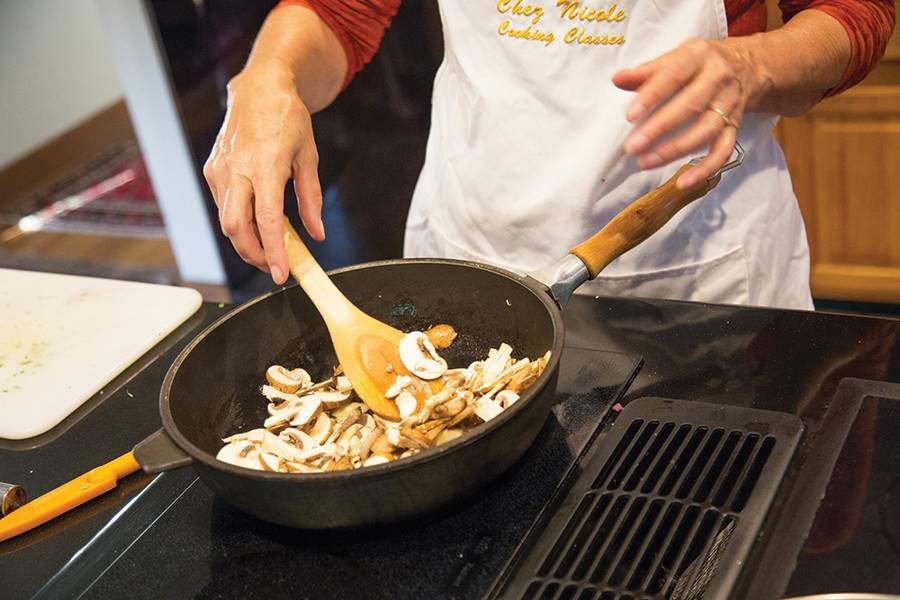
Secrets of French home cooking from Chez Nicole
When Nicole Spaulding invites you into her Wakefield home, don’t be fooled. You may think you’re on the set of The French Chef, Julia Child’s beloved 1980s cooking show. The house, tucked away at the end of a dirt road, may remind you of the French countryside. Nicole will welcome you with a French accent and guide you to her kitchen, outfitted with antique French furniture. And you will spend a few hours cooking and eating some very French food. But you won’t actually be on television. Even more, those few hours will contradict everything you think you know about French cuisine.
“Every time we host a cooking class,” her husband Malcolm says as we sit down to enjoy the food we’ve been cooking that evening at Chez Nicole, “people ask whether we eat like this every day. And the answer is yes.” It’s hard to believe. A few fellow students and I, under Nicole’s guidance, have made a bounty: Salmon Rillettes; Cherry Tomato, Basil and Goat Cheese Salad with a homemade dressing; Chicken, Grape and Walnut Salad with our own mayonnaise; Zucchini Gratin; Roasted Pork Tenderloin with Mushroom Cream Sauce; Plum Clafoutis and Flourless Dark Chocolate Cakes. It’s hard to imagine cooking like that once a week, never mind once a day. “It’s true,” Nicole says. “But what on this table took more than 20 minutes?”
That’s her goal at Chez Nicole: to take her native French cooking, which Americans perceive as difficult, fussy, heavy food, and to demystify it. “I come from a family where cooking is a religion,” she says. “Everybody cooked. The dinner table would be a competition.” Looking around at all the dishes on the table, I realized that though we had made a lot of food, and that I wouldn’t normally make seven dishes for a meal, I could easily recreate any of it at home, and with little fuss. Nicole also emphasizes making simple things that will keep for weeks, if not months, if stored properly. I started my lesson that day by poaching salmon for Salmon Rillette, which is similar to a pate, but is a combination of cooked salmon, lox, white wine and shallots, with a few delicious ingredients to bind them. It takes about 20 minutes to prep, and maybe an hour to chill and set, and will keep in the refrigerator for about ten days, even though it’s fish. “Think about it,” Nicole says. “Oil is a preservative, salt is a preservative. You can make it once and have it for days.” The same is true of her very simple, very delicious salad dressing, which she makes by the large batch and has for months at a time.
Everything else was just as easy to make: Plum Clafoutis was just fresh plums baked in a vanilla custard cake. It took minutes to prepare. The pork – roasted and then finished with a quick sauce of mushrooms, mustard and cream. Easy enough for a Tuesday night. As we enjoyed our meal, Nicole told us about her home in the Southwest of France, where she and her husband still split their time. “If you think, where is the best place in France for food,” she says of the region known for truffles and foie gras, “that’s where I come from.” Her French sensibility of simplicity, and of eating the freshest, best foods of the season, was the takeaway from the class. There wasn’t a bechamel, or an escargot, or any other fussy food in sight. Nicole offers private cooking classes at her home in Wakefield.
ChezNicoleCookingClasses.com
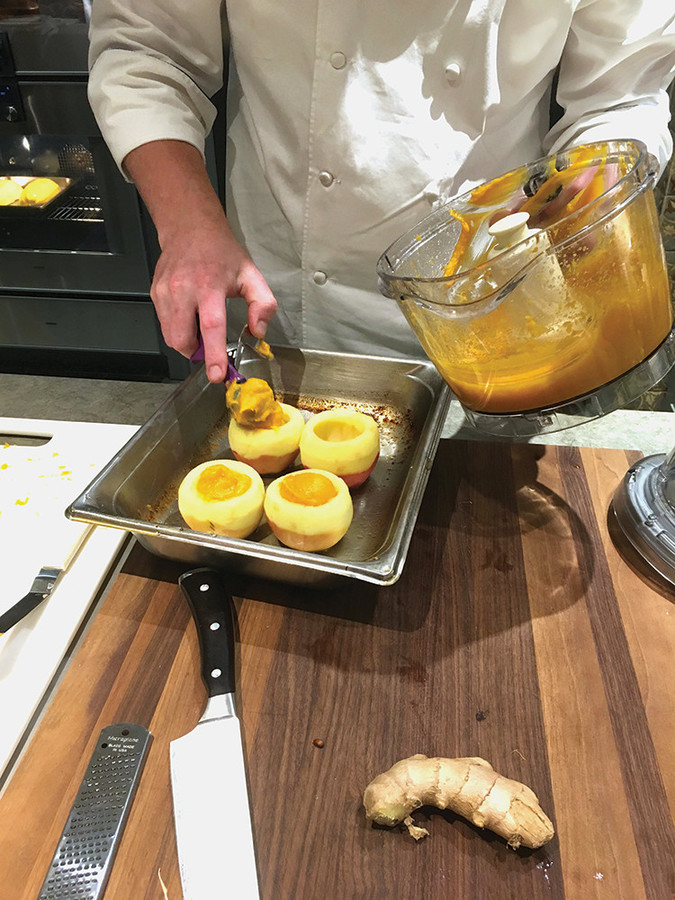
New ideas for winter squash at Ocean House
“A lot of chefs say fall is their favorite season to cook, but I prefer late winter,” says Chef Paul McComisky, director of culinary education at Ocean House, the tony resort in Watch Hill. “It’s a challenge. If you’re doing farm to table you kind of have to regress,” to earlier ways of thinking about food, he says. “They really had to think ahead.” Homesteaders would spend summer canning and fall shoring up hearty foods so that they had food to eat for winter, and that’s how Chef Paul thinks about winter food, too – using the harvest from the previous year to make sure he can still eat as locally as possible, even outside of the growing season. A big part of winter food 100 years ago was winter squash, and it’s a big part of winter food at Ocean House, where the chefs make it a priority to serve food from local purveyors and to cook with the seasons. It’s such a big priority, in fact, that Chef Paul is also the hotel’s food forager, meaning that he goes to farms all over New England to get food for the restaurants at Ocean House. “It’s a little bit of me playing Match.com between chefs and farmers,” he says. At the beginning of strawberry season, he’ll select berries from five different farms, then bring them back to the pastry chef for her to pick which she wants for certain desserts.
Chef Paul also teaches several culinary classes per week, both for guests of the hotel and to the public. This day, we’re here for a Winter Squash class, set in a tucked away space called The Center for Wine and Culinary Arts. It looks like the set of a cooking show, and it’s also home to an 8,000 bottle wine cellar, which Chef Paul let me look inside with the promise that I wouldn’t break anything. “The whole idea of having a hotel school is to make the food and wine approachable to guests,” he says. I’m particularly excited about this class, because I know two ways to make squash, and neither of them excite me all that much. The mistake most people make, Chef Paul says as he splits a spaghetti squash in two, is boiling the gourds. They already have a high water content to survive being off the vine all winter, so boiling them adds unnecessary water and dilutes the flavor. Check. That’s exactly why I skip the butternut squash puree at Thanksgiving dinner. Instead, he suggests, roast it with some butter, olive oil and apple cider, then use that juice as your liquid when you puree it. I’m still a little dubious when he hands me a poached apple that’s been hollowed out and filled with the squash, but not after I take a bite. It’s easily the brightest, best flavor I’ve tasted from a squash. I immediately start putting together a dinner party menu around the side dish, asking Chef Paul for a vegan modification (which is as simple as subbing out the butter for oil).
He then takes us through a handful of different varieties of squash, like red curry, sugar dumpling, blue hubbard and delicata, which he sourced from farms in Connecticut and Rhode Island. His favorite is blue hubbard. “If pumpkins have the least flavor of the squash family, blue hubbard has the most,” he says. The pastry chef used it for squash ice cream all last winter, which they would run out of every week. Chef Paul shows us recipes for a Ginger Squash Soup and Spaghetti Squash Latkes, in addition to those Poached Apples with Squash Puree. They’re all perfectly in season, and totally different than anything I’ve had before. The next day, I went to a farm and bought a 15lb blue hubbard squash to make soup for the coming winter. Eating with the seasons, indeed. Ocean House has a Savory to Sweet class on November 5, a Thanksgiving Leftovers class on November 26 and a Cocktails and Hors d’Oeuvres class on December 15.
OceanHouseEvents.com
Comments
No comments on this item Please log in to comment by clicking here